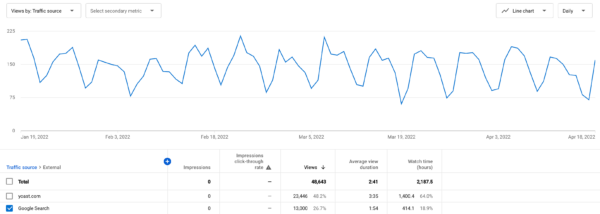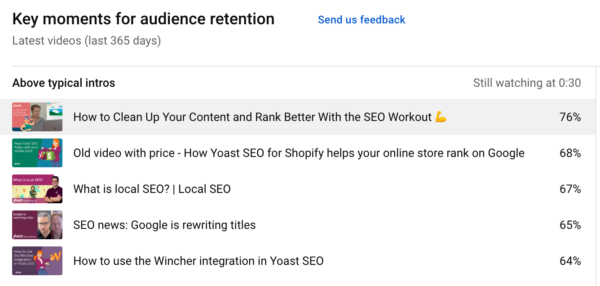Are you using YouTube to host and distribute your videos? Then one of the main ways you’ll want to drive views is through search. Not just search within YouTube itself, but Google search as well. In this post, we’ll go over the five core YouTube metrics you should be looking at on a regular basis to understand and measure how your videos when it comes to driving organic search traffic on both platforms.
Note that this is not an overview of how to measure YouTube marketing more broadly. For that, check out our post on how to use analytics to optimize your video. This post discusses the YouTube metrics most important for tracking and optimizing traffic to your YouTube videos. From both Google and YouTube search. Metrics that you can all find in YouTube Analytics.
Metric 1: Views from YouTube search
The first metric that you should look at is the number of views acquired from YouTube Search. This data is available via the Traffic sources report in YouTube Analytics. “YouTube Search” is clearly marked as a source distinct from other YouTube discovery methods. This data shows you how many people find your videos via search within the YouTube platform (i.e. website, apps & integrations). It does not include traffic from Google search or other search engines.
Views from YouTube search is really your headline metric for YouTube SEO (although not Video SEO, more broadly conceived). When this metric goes up, this tells you more people are discovering and watching your videos through YouTube search.
Metric 2: Views from Google search

This data is also available via the Traffic Sources report in YouTube Analytics, but within the “External” category. Here you can see “Google Search” as a source alongside other websites where your videos are embedded or linked to. Views from Google Search tell you how many people have reached your videos on YouTube.com or the YouTube app through universal Google search or Google video search. It does not, however, include users that watched videos on your website and arrived at your website via Google search. These are captured and referenced as other “External” sources.
This metric is extremely useful if you trying to optimize your YouTube channel for visibility on Google search. Particularly by ranking for unbranded informational keywords. You’ll typically find that this graph may show a spike if a new video starts to rank in a video pack within Google universal search for a high-volume keyword. So this is a useful indicator of whether or not your videos are appearing frequently within those rich results packs.
Are you seeing a significant number of views on your channel coming from Google search, but very few from YouTube search? This is a good clue that you might be better off moving your videos to a different platform. Especially if you have a website with good authority and reputation. That way you can drive traffic exclusively to your website, rather than pushing everything by default to YouTube. My post on YouTube vs your own site: which is better for SEO? can help you decide whether this is the right course of action for you.
Metric 3: Average percentage viewed

The third YouTube metric I want to discuss is the average percentage viewed for all videos in a channel. This data shows you how much of your videos viewers typically get through. It can also be viewed on an individual video basis via heatmaps or as aggregated data for all your videos. While this data doesn’t directly speak to your video performance in terms of rankings, it is a good leading indicator of wider visibility. YouTube either directly uses average retention data to inform rankings, or it correlates closely with factors that do feed into the algorithm. As such, if you improve average retention, you tend to find that you get more views.
The average percentage viewed also tells you, essentially, how good your content is and how much it meets user needs. Although it’s important to note that longer videos have lower average retention figures. The aggregated view is helpful. A downward trend (as above) tells you something might be awry with recently published content in terms of quality or targeting. But it actually gets particularly helpful when you drill down into individual videos via the Engagement tab in YouTube analytics. This helps you see which have the highest and lowest retention rates after 30 seconds.

Metric 4: Views from non-subscribers

Our fourth YouTube metric is the number of views from non-subscribers to your YouTube channel. Views from subscribers tend to come via notifications and recommendations within the YouTube platform infrastructure. Whereas sidebar recommendations, social media and search tend to be the engines that drive new viewers.
As such, the number of views from non-subscribers is an important metric for search optimization. It holds particular relevance for those channels that have large engaged audiences and tend to use subscribers as the main engine of new views, but are keen to expand their reach.
Metric 5: Impressions click-through rate

Our final metric is the average impressions click-through rate for your videos. This data tells you how many people click on your video when they see it presented in search results and sidebar recommendations. Although it only includes data from the YouTube platform itself and does not cover click-through rate as it relates to visibility in Google search. The metric correlates significantly with the number of views you are able to drive to your videos. And may even be a direct or indirect factor in determining rankings and wider visibility across YouTube.
More broadly, however, it speaks to how good your thumbnails and video titles are, and whether they match user needs for the queries you are targeting. You should be comparing this number to your own performance over time. Try to improve it as you create new content and further refine your channel value proposition. Small changes in click-through rate often lead to a big impact on the total number of impressions and views you can get for your videos. If you can move the dial by 1-2% over a number of months, this will have a huge impact on visibility and traffic.
While optimizing for impressions click-through rate on YouTube doesn’t necessarily translate into a better click-through rate on Google search, in most cases optimizing for one leads to a better performance in the other.
Use these YouTube metrics to monitor your organic traffic
In this post, I discussed five core YouTube metrics that can serve as a base for your SEO efforts. I hope it gave you some tools to monitor the performance of your videos when it comes to organic traffic. If you want to dive even deeper into the data to optimize your videos, make sure to check out my post on how to use YouTube analytics to optimize your video.


